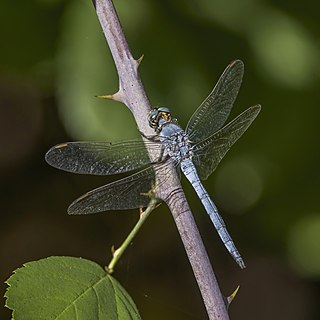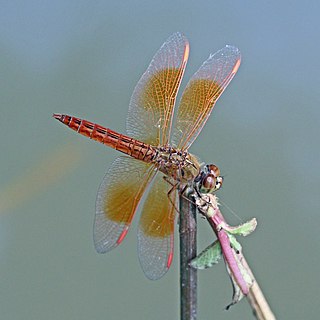
Odonata is an order of flying insects that includes the dragonflies and damselflies.

The black-tailed skimmer is a dragonfly belonging to the family Libellulidae.

The red-veined darter or nomad is a dragonfly of the genus Sympetrum.

The common darter is a dragonfly of the family Libellulidae native to Eurasia. It is one of the most common dragonflies in Europe, occurring in a wide variety of water bodies, though with a preference for breeding in still water such as ponds and lakes. In the south of its range adults are on the wing all year round.

The keeled skimmer is a species of dragonfly belonging to the family Libellulidae.

The large red damselfly is a species of damselflies belonging to the family Coenagrionidae. It is native to the western Palearctic.

The blue-tailed damselfly or common bluetail is a damselfly, belonging to the family Coenagrionidae.

The southern hawker or blue hawker is a species of hawker dragonfly.

The ruddy darter is a species of dragonfly of the family Libellulidae.

Brachythemis is a genus of dragonflies in the family Libellulidae. They are commonly known as groundlings.

Brachythemis leucosticta, the banded groundling or Southern banded groundling, is a species of dragonfly belonging to the family Libellulidae. It is found in Sub-Saharan Africa.

Sympecma fusca, the common winter damselfly, is a damselfly a member of the Lestidae and related to the emeralds or spreadwings.

The band-winged meadowhawk is a dragonfly of the genus Sympetrum belonging to the family Libellulidae.

The eastern amberwing is a species of dragonfly in the family Libellulidae. It is very small, reaching a total length of no more than 25 millimetres (0.98 in). The males have orange or amber wings. Both sexes have a red pterostigma.

Chalcolestes viridis, formerly Lestes viridis, is a damselfly of the family Lestidae. It has a metallic green body and at rest it holds its wings away from its body. Its common name is the willow emerald damselfly, the green emerald damselfly, or the western willow spreadwing. It has an elongated abdomen and pale brown spots on its wings and resides in areas of still water with overhanging trees.

Orthetrum brunneum, the southern skimmer, is a species of 'skimmers' belonging to the family Libellulidae.

Sympetrum meridionale, the southern darter, is a species of dragonfly belonging to the Skimmer family Libellulidae.

Orthetrum serapia, the green skimmer, is a freshwater dragonfly in the family Libellulidae. The serapia species is present in Australia, the Philippines, Fiji, Papua New Guinea and Solomon Islands. It inhabits a wide range of still and sluggish waters, often shallow. In Australia it ranges from the top end of the Northern Territory to about Mackay in central Queensland.

Brachythemis contaminata, ditch jewel, is a species of dragonfly in the family Libellulidae. It is found in many Asian countries.

Bradinopyga geminata is a species of dragonfly in the family Libellulidae known commonly as the granite ghost. It is native to India, Sri Lanka and Thailand, where it is a common and widespread species.























